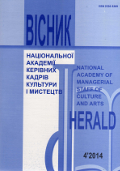СОЦІАЛЬНО-ПРАВОВІ ВІДНОСИНИ НА ЕТНІЧНИХ УКРАЇНСЬКИХ ЗЕМЛЯХ: ХІV – перша половина ХVІ ст.
Social and legal relations on ethnic Ukrainian lands: XIV – the first half of the XVI centuries.
Author(s): Olena MalozhonSubject(s): Anthropology, Cultural history, Ethnohistory, 13th to 14th Centuries, 15th Century
Published by: Національна академія керівних кадрів культури і мистецтв
Keywords: socio-economic relations; the Lithuanian and Rus state; old Russian traditions; Lyublinska Union; russian right;
Summary/Abstract: In the article the social and local relations of Ukraine are analysed in composition Lithuania and Poland in the XIV – the first half of the XVI centuries. This period characterized a cultural revival, distribution of humanism ideas of the Reformation, social and national revolutions. In the XIII – the first half of the XIV centuries, successor state of on its south-western lands was Galicia-Volhynia. It is traced, that at the same time becoming of basic lines of colloquial Ukrainian was with forming of Ukrainian nationality and continued cultural development of Ukrainian nationality.Lithuanian tribes have been the north-western neighbors of the Eastern Slavs for a long time. In the "Tale of Bygone Years" are mentioned their own political organization, and paying the tribute to Kyiv. "Lithuania from the swaps doesn’t show itself for anybody" – the author of "Word of the death of Russian land" pointed out in the middle of the thirteenth century. However, it evolved into the early feudal state, the Duchy of Lithuania. After the addition of the most part of the modern Ukrainian, Belarusian and Russian lands Lithuania became a great feudal state. The Lithuanians called it the Grand Duchy of Lithuania, Russ and Zhemaytiyske. Russian land amounted to 9/10 of the total area of the principality, and had a great impact on the socio-political and cultural life of Lithuania. Russian language became the official one; many rules from "Russian Truth", the local name of social conditions, government offices were taken by Lithuanians. The administrative divisions being characteristic of Kievan Rus, was restored. The territory was divided into separate principalities which have the autonomous status.During the second half of the XIV – the beginning of the XV centuries the partial assimilation of the Lithuanians in the powerful Slavic array was held. The following facts testify about the assimilation of the Lithuanian rulers. They are many marital relationships of the local and Lithuanian nobles, the expansion of the Russian Orthodoxy influence in the territories of the Lithuanian state, the establishment of "Russian Truth" as a state legal basis; recognition of the Ruthenian language as an official language; borrowing Russian military experience of building forts and setting the tax system, formation of the princely administration structure. The local name of social conditions, government offices were taken by Lithuanians. The administrative divisions being characteristic of Kievan Rus, was restored. The territory was divided into separate principalities which have the autonomous status. It encouraged the Ukrainian elites to support the Lithuanians, and the lower classes not to resist against the domination of Lithuania. These facts proved Hrushevsky’s theory. He argued that the Grand Duchy of Lithuania kept the tradition of Kievan Rus better than Moskow state did it. The modern authors call Lithuanian penetration of the Ukrainian land "velvet". Joining the western Russian lands, Lithuania took over their higher culture and experience of political organization. It led to the convergence of Lithuanian and Ruthenian nobility, "slavification", "Russification" of Lithuanian princes, who married with the ruthenian princesses and lord, moved into the Orthodox faith, took the local language, way of life and customs.After 1569 Ukrainian lands were divided into seven provinces: Rus (Galicia), Belz, Volyn, Bratslav, Kiev, Podolsk and Chernihiv (formed in 1635 after the "true Polish" Chernihiv and Siverschyna were taken from Moscow). The Lithuanian law (Statutes 1566 and 1588) was on these territories (except Galicia). The large cities were guided by the provisions of the Magdeburg Law. However, despite of these factors, the Polish lords extended their power on the most part of Ukraine [1].The Orthodox Church became illegal. The Uniate cathedral decision didn’t meet either the interests or sentiments of the majority of the Ukrainian population who thought that the Orthodoxy church was a symbol of the national liberation struggle. The Catholic Church was seen as an instrument of foreign oppression. So the natural conse-quence of the Brest Union was the religious schism in Ukraine. Thus, the inclusion of Ukrainian lands to the Polish-Lithuanian Commonwealth laid the ground for the future conflict in society and brought a rapid increasing of the Ukrainian people exploitation, national and religious discrimination and catholization.
Journal: Вісник Національної академії керівних кадрів культури і мистецтв
- Issue Year: 2014
- Issue No: 4
- Page Range: 174-180
- Page Count: 7
- Language: Ukrainian

